Learning Sets Theory Using Shadow Puppet: A Study of Javanese Ethnomathematics
Abstract
1. Introduction
2. Methods
3. Results and Discussion
3.1. Concept of Sets in Arranging the Puppet Characters on the Screen of Kelir
Sadewa, Duryudana, Dursasana, Kertamarma, Citraksa, Citraksi,
Dewi Amba, Dewi Kunti, Dewi Gendari, Srikandi, Pandu Dewanata,
Sengkuni, Bhisma, Destrarasta, Kresna}.
Dewi Gendari, Destrarasta}.
Dewi Kunti, Dewi Madrim, Srikandi, Krishna, Pandu Dewanata, Bhisma}.
Pandhawa ⊂ Simpingan Kanan
3.2. Noble Values in the Shadow Puppet Performance
3.3. Ethnomathematics and Character Education in Puppet Culture
4. Conclusions
Author Contributions
Funding
Institutional Review Board Statement
Informed Consent Statement
Data Availability Statement
Acknowledgments
Conflicts of Interest
References
- Purwanto, S. Pendidikan nilai dalam pagelaran wayang kulit. Ta’allum J. Pendidik. Islam 2018, 6, 1–30. [Google Scholar] [CrossRef]
- Soetarno, S. Makna pertunjukan wayang dan fungsinya dalam kehidupan masyarakat pendukung wayang. Dewa Ruci 2011, 7, 300–332. [Google Scholar]
- Ramli, W.N.R.W.; Lugiman, F.A. The contribution of shadow puppet’s show through engaging social communication in modern society. Procedia Soc. Behav. Sci. 2012, 35, 353–360. [Google Scholar] [CrossRef]
- Risdiyanti, I.; Prahmana, R.C.I. The learning trajectory of number pattern learning using Barathayudha war stories and uno stacko. J. Math. Educ. 2020, 11, 157–166. [Google Scholar] [CrossRef]
- Risdiyanti, I.; Prahmana, R.C.I. Designing learning trajectory of set through the Indonesian shadow puppets and Mahabharata stories. Infinity 2021, 10, 331–348. [Google Scholar] [CrossRef]
- Sari, A.P. Filosofi karakter tokoh kesatria dalam lakon wayang purwa Mahabarata. Piwulang J. Pendidik. Bahasa Jawa 2021, 9, 13–25. [Google Scholar]
- Zaid, A. Javanese philosophy as an alternative in teaching character building. In Proceedings of the UNNES International Conference on ELTLT, Semarang, Indonesia, 8–9 October 2016; pp. 10–13. [Google Scholar]
- Stenberg, J. Wayang potehi: Glove puppets in the expression of Sino-Indonesian identity. J. Southeast Asian Stud. 2015, 46, 391–416. [Google Scholar] [CrossRef]
- Smith, J. Karagoz and Hacivat: Projections of subversion and conformance. Asian Theatre J. 2004, 21, 187–193. [Google Scholar] [CrossRef]
- Hussein, N.H. The revitalization of the Aragoz puppet in Egypt: Some reflections. Pop. Entertain. Stud. 2012, 3, 57–70. [Google Scholar]
- Chen, F.P. Shadow theaters of the world. Asian Folk. Stud. 2003, 62, 25–64. [Google Scholar]
- Yousof, G.S. The shadow plays of Southeast Asia: Relationships between the various forms. SPAFA J. 2006, 16, 5–16. [Google Scholar]
- Mishra, P. Cultural history of Indian diaspora in Cambodia. Int. J. Humanit. Soc. Sci. Invent. 2013, 2, 67–71. [Google Scholar]
- Srisuchat, A. Mahabharata in art and literature in Thailand. Indian Lit. 2005, 49, 105–114. [Google Scholar]
- Dewanto, M.R.; Widodo, W.; Savitri, S. Poster anti narkoba melalui karakter tokoh wayang dalam gaya seni psikedelik. Atrat J. Seni Rupa 2017, 5, 61–68. [Google Scholar]
- Sunaryo, A. Rupa Wayang; CV Kekata Group: Surakarta, Indonesia, 2020. [Google Scholar]
- Hall, K.R. Traditions of knowledge in old Javanese literature, c. 1000–1500. J. Southeast Asian Stud. 2005, 36, 1–27. [Google Scholar] [CrossRef]
- Riantiarno, N. Mahabarata; Gramedia Widiasarana Indonesia: Jakarta, Indonesia, 2016. [Google Scholar]
- Utorowati, S.; Sukristanto, S.; Israhayu, E.S. Nilai Pendidikan Karakter dalam Novel Mahabarata dan Novel Bisma Dewabrata: Sebuah Kajian Intertekstual. In Proceedings of the 8th University Research Colloquium (URECOL), Jawa Tengah, Indonesia, 4 September 2018; pp. 348–353. [Google Scholar]
- Pramono, Y.L.; Suyanto, S.; Wahida, A. Shadow puppet arts as the formation of young generation character. In Proceedings of the International Conference on Art, Language, and Culture, Surakarta, Indonesia, 4 November 2017; pp. 397–404. [Google Scholar]
- Brandon, J.R. On Thrones of Gold: Three Javanese Shadow Plays; University of Hawai’s Press: Honolulu, HI, USA, 1993; pp. 15–21. [Google Scholar]
- Tannenbaum, K. Carving Out a New Future: Waying Kulit Craftsmanship in Central Java, Indonesia. Ph.D. Thesis, University of Hawaii at Mānoa, Honolulu, HI, USA, 2018. [Google Scholar]
- Khor, K.K. Digital Puppetry of Wayang kulit Kelantan: A study of its Visual Aesthetics/Khor Kheng Kia. Ph.D. Thesis, University of Malaya, Malaya, Malaysia, 2014. [Google Scholar]
- Freudenthal, H. Revisiting Mathematics Education: China Lectures; Springer Science & Business Media: Cham, Switzerland, 2006; Volume 9. [Google Scholar]
- D’Ambrosio, U. Ethnomathematics: Perspectives. N. Am. Study Group Ethnomath. News 2007, 2, 2–3. [Google Scholar]
- Risdiyanti, I.; Prahmana, R.C.I. Ethnomathematics: Exploration in Javanese culture. J. Phys. Conf. Ser. 2017, 943, 012032. [Google Scholar] [CrossRef]
- Alangui, W.V. Stone Walls and Water Flows: Interrogating Cultural Practice and Mathematics. Ph.D. Thesis, University of Auckland, Auckland, New Zealand, 2010. [Google Scholar]
- Muhtadi, D.; Sukirwan, S.; Warsito, W.; Prahmana, R.C.I. Sundanese Ethnomathematics: Mathematical activities in estimating, measuring, and making patterns. J. Math. Educ. 2017, 8, 185–198. [Google Scholar] [CrossRef]
- Joseph, G.G. The Crest of the Peacock: Non-European Roots of Mathematics; Princeton University Press: New Jersey, NJ, USA, 2010. [Google Scholar]
- D’Ambrosio, U. An overview of the history of Ethnomathematics. In Current and Future Perspectives of Ethnomathematics as a Program; Rosa, M., D’Ambrosio, U., Orey, D.C., Shirley, L., Alangui, W.V., Palhares, P., Gavarrete, M.E., Eds.; Springer: Cham, Switzerland, 2016; pp. 5–10. [Google Scholar]
- D’Ambrosio, U. Ethnomathematics and its place in the history and pedagogy of mathematics. Learn. Math. 1985, 5, 44–48. [Google Scholar]
- Rosa, M.; Orey, D.C. State of the art in Ethnomathematics. In Current and Future Perspectives of Ethnomathematics as a Program; Rosa, M., D’Ambrosio, U., Orey, D.C., Shirley, L., Alangui, W.V., Palhares, P., Gavarrete, M.E., Eds.; Springer: Cham, Switzerland, 2016; pp. 11–37. [Google Scholar]
- Rahmawati, Y. Pendekatan matematika realistik bernuansa Etnomatematika: Rumah gadang minangkabau pada materi teorema pythagoras. J. Azimut 2020, 3, 22–29. [Google Scholar]
- Putra, R.Y.; Wijayanto, Z.; Widodo, S.A. Etnomatematika: Masjid Soko Tunggal dalam pembelajaran geometri 2D. Pendidik. Mat. 2020, 4, 10–22. [Google Scholar] [CrossRef]
- Nursyahidah, F.; Saputro, B.A.; Albab, I.U.; Aisyah, F. Pengembangan learning trajectory based instruction materi kerucut menggunakan konteks megono gunungan. Mosharafa J. Pendidikan Matematika 2020, 9, 47–58. [Google Scholar]
- Prahmana, R.C.I.; Yunianto, W.; Rosa, M.; Orey, D.C. Ethnomathematics: “Pranatamangsa” system and the birth-death ceremonial in Yogyakarta. J. Math. Educ. 2021, 12, 93–112. [Google Scholar] [CrossRef]
- Nurjanah, N.; Mardia, I.; Turmudi, T. Ethnomathematics study of Minangkabau tribe: Formulation of mathematical representation in the Marosok traditional trading. Ethnogr. Educ. 2021, 16, 1–20. [Google Scholar] [CrossRef]
- DeJarnette, A.F.; Lausell, S.L.R.; González, G. Shadow puppets: Exploring a context for similarity and dilations. Math. Teach. 2015, 109, 20–27. [Google Scholar] [CrossRef]
- Putri, W.P.; Tanto, O.D.; Kusumastuti, N. Learning math through making shadow puppet. Int. J. Progress. Sci. Technol. 2021, 27, 342–347. [Google Scholar]
- Shirley, L.; Palhares, P. Ethnomathematics and its Diverse Pedagogical Approaches. In Current and Future Perspectives of Ethnomathematics as a Program; Rosa, M., D’Ambrosio, U., Orey, D.C., Shirley, L., Alangui, W.V., Palhares, P., Gavarrete, M.E., Eds.; Springer: Cham, Switzerland, 2016; pp. 13–17. [Google Scholar]
- Ascher, M.; D’Ambrosio, U. Ethnomathematics: A dialogue. Learn. Math. 1994, 14, 36–43. [Google Scholar]
- Nugroho, S. The aesthetics effect of surakarta-style pakeliran on East Javanese pakeliran. Harmon. J. Arts Res. Educ. 2018, 18, 153–161. [Google Scholar] [CrossRef][Green Version]
- Petersen, R. The Character of the kafir: Domains of evil in the wayang golek menak of Central Java. Asian Theatre J. 1994, 11, 267–274. [Google Scholar] [CrossRef]
- Sutiyono, S.; Rumiwiharsih; Suharjana, B. Pemuliaan tanaman padi melalui pertunjukan wayang kulit dalam upacara bersih desa di geneng, trucuk, klaten, Jawa Tengah. Mudra J. Seni Budaya 2018, 33, 263–276. [Google Scholar] [CrossRef][Green Version]
- Sulaksono, D. Filosofi pertunjukan wayang purwa. Ibda J. Kajian Islam Budaya 2013, 11, 238–246. [Google Scholar] [CrossRef][Green Version]
- Junaidi, J.; Haryono, H. Merancang boneka wayang remaja. Lakon J. Pengkaj. Pencipta. Wayang 2008, 5, 1–10. [Google Scholar]
- Haryadi, T.; Khamadi. Perancangan model wujud visual tokoh pewayangan dalam pembentukan identitas dan watak tokoh sebagai acuan desain karakter dalam karya DKV. DeKaVe 2014, 7, 56–77. [Google Scholar] [CrossRef]
- Walpole, R.E. Pengantar Statistika; Gramedia Pustaka Utama: Jakarta, Indonesia, 2010. [Google Scholar]
- Evans, M.J.; Rosenthal, J.S. Probability and Statistics: The Science of Uncertainty; Macmillan: New York, NY, USA, 2004. [Google Scholar]
- Ras, J.J. The social function and cultural significance of the Javanese Wayang Purwa theatre. Indones. Circ. 1982, 10, 19–32. [Google Scholar]
- Handayani, C. The re-animation of the traditional folk arts as the ancestors cultural heritage at bukit menoreh bhumi sambhara budhara. Harmon. J. Arts Res. Educ. 2006, 7, 1–12. [Google Scholar]
- Wright, L. Indonesia: Myth and reality in the land of the shadow puppet. Int. Stud. Manag. Organ. 1994, 24, 35–60. [Google Scholar] [CrossRef]
- Pandin, M.G.R. Moral-ethics-belief values towards Indonesian puppet (Wayang kulit) performance arts. Utop. Prax. Latinoam. 2020, 25, 515–521. [Google Scholar]
- Jimat, J. Perspektif Pendidikan Islam Terhadap Ajaran Hastha Brata Dalam Wayang Kulit Serta Relevansinya Dengan Pendidikan Masa Kini. Undergraduate Thesis, IAIN Walisongo, Semarang, Indonesia, 2008. [Google Scholar]
- Kasim, S. Wayang dalam kajian ontologo, epistimologi dan aksiologi sebagai landasa filsafat ilmu. J. Sangkareang Mataram 2018, 4, 47–50. [Google Scholar]
- Siswanto, N. Perubahan pandangan ontologi pada wayang masa islam dan pra islam. J. Filsafat 2017, 27, 106–118. [Google Scholar] [CrossRef][Green Version]
- Hadiprayitno, K. Tontonan, tatanan, dan tuntunan aspek penting dalam aksiologi wayang. In Proceedings of the Sarasehan Senawangi Kongres IX Senawangi, Cipayung, Jakarta, 25–26 April 2017. [Google Scholar]
- Sabunga, B. Nilai-nilai karakter dalam pertunjukan wayang golek purwa. Sosio Religi J. Kajian Pencipta. Umum 2016, 14, 1–12. [Google Scholar]
- Suparjo. On land (wealth) distribution: A cultural approach to justice in Indonesia. Indon. L Rev. 2011, 1, 334–348. [Google Scholar] [CrossRef][Green Version]
- Trivedi, S. Early Indian influence in Southeast Asia: Revitalizing partnership between India and Indonesia. India Q. 2010, 66, 51–67. [Google Scholar] [CrossRef]
- Lim, S.L. Transmitting the Ramayana Epic from India to Southeast Asia and the West through Shadow Puppetry and Visual Art; Northern Illinois University: DeKalb, IL, USA, 2010. [Google Scholar]
- De Lange, J. Using and applying mathematics in education. In International Handbook of Mathematics Education; Springer: Dordrecht, The Netherlands, 1996; pp. 49–97. [Google Scholar]
- Van den Heuvel-Panhuizen, M.H.A.M. Assessment and Realistic Mathematics Education; Utrecht University: Utrecht, The Netherlands, 1996; Volume 19, pp. 9–272. [Google Scholar]
- D’Ambrosio, U. Ethnomathematics and its first international congress. ZDM 1999, 31, 50–53. [Google Scholar] [CrossRef]
- Psomos, P.; Kordaki, M. Pedagogical analysis of educational digital storytelling environments of the last five years. Procedia Soc. Behav. Sci. 2012, 46, 1213–1218. [Google Scholar] [CrossRef][Green Version]
- Soerjoatmodjo, G.W.L.; Kaihatu, V.A.M. Family decision-making process on cultural heritage appreciation in Akhir Pekan@ Museum Nasional. Procedia Soc. Behav. Sci. 2016, 222, 539–547. [Google Scholar] [CrossRef][Green Version]
- Dhari, Y.W. Pewarisan keahlian mendalang pada keluarga dalang wayang golek abah sunarya. Umbara 2019, 4, 130–140. [Google Scholar] [CrossRef]
- Prahmana, R.C.I.; D’Ambrosio, U. Learning geometry and values from patterns: Ethnomathematics on the Batik patterns of Yogyakarta, Indonesia. J. Math. Educ. 2020, 11, 439–456. [Google Scholar] [CrossRef]
- Supiyati, S.; Hanum, F.; Jailani. Ethnomathematics in Sasaknese architecture. J. Math. Educ. 2019, 10, 47–58. [Google Scholar] [CrossRef]
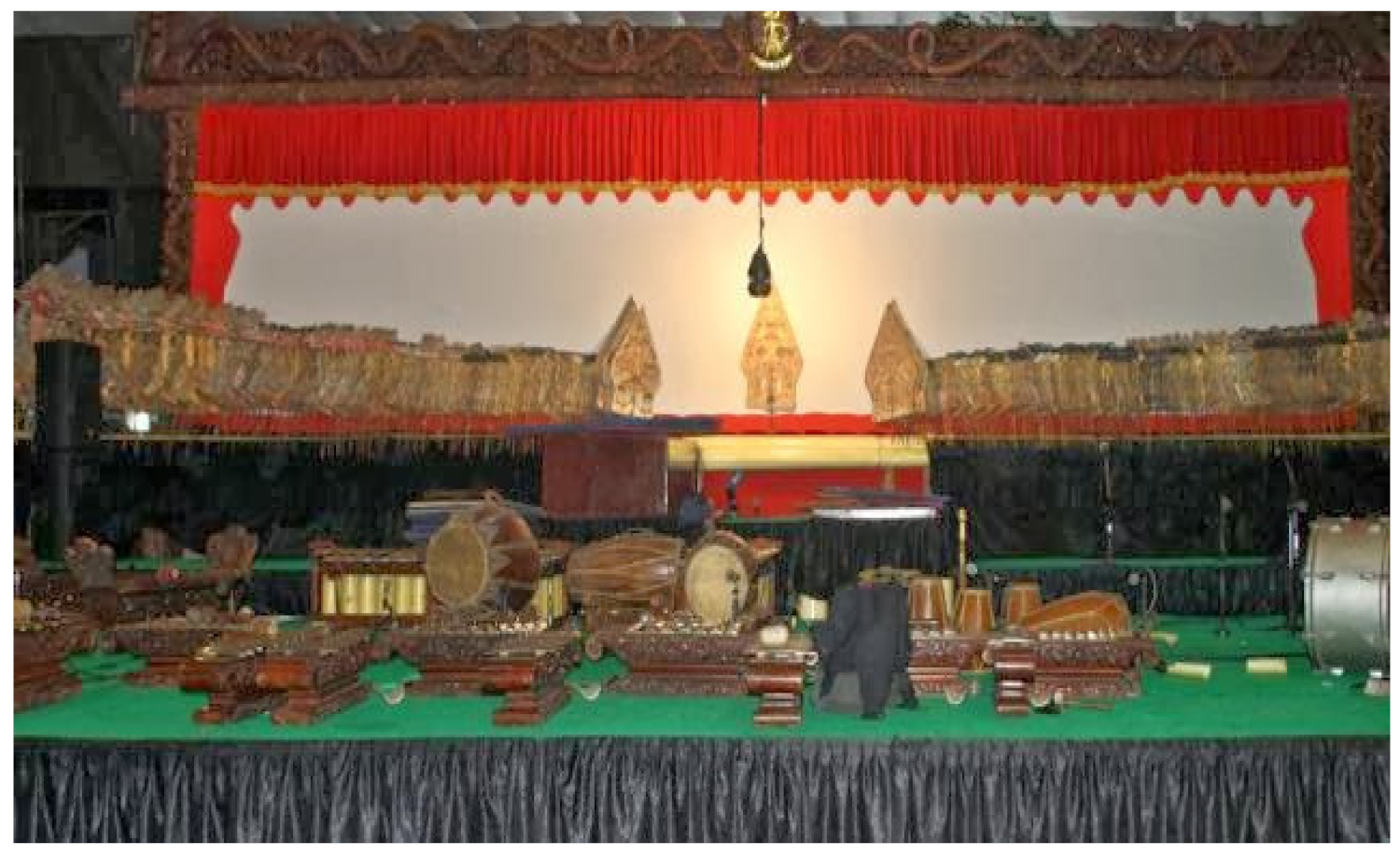
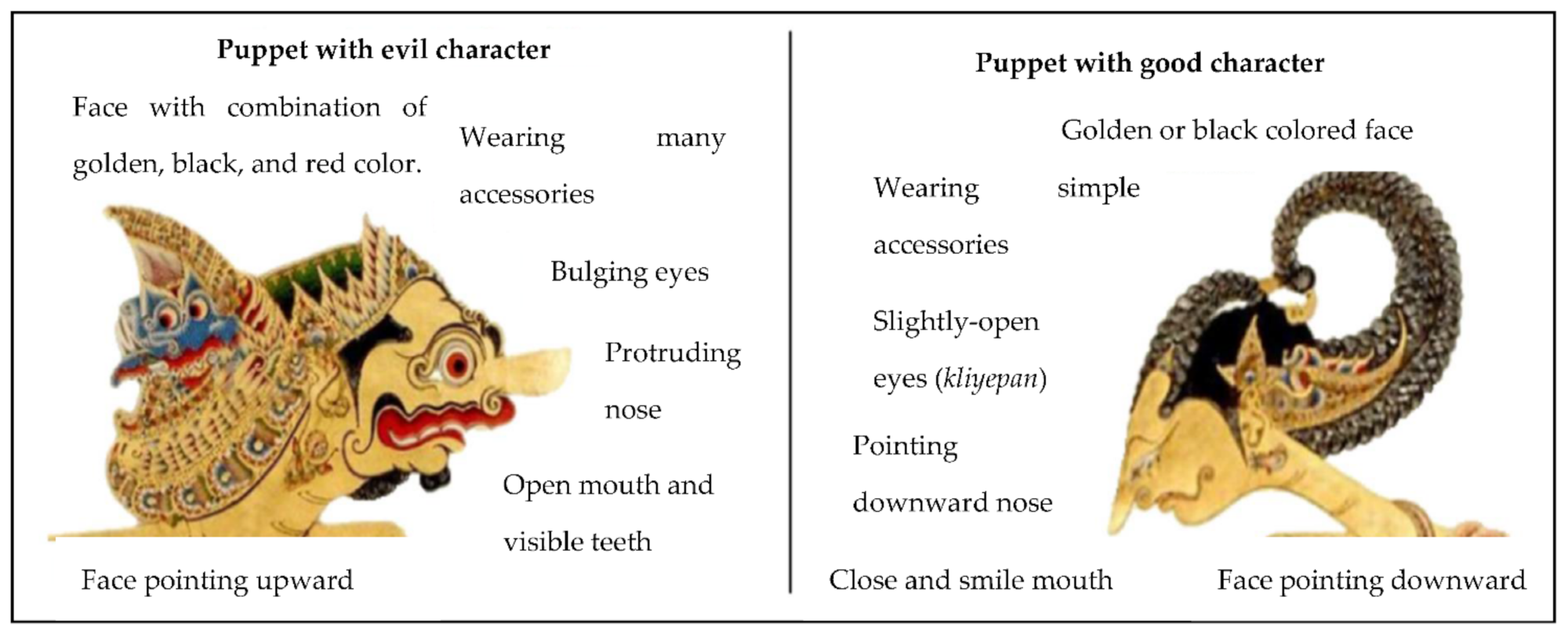
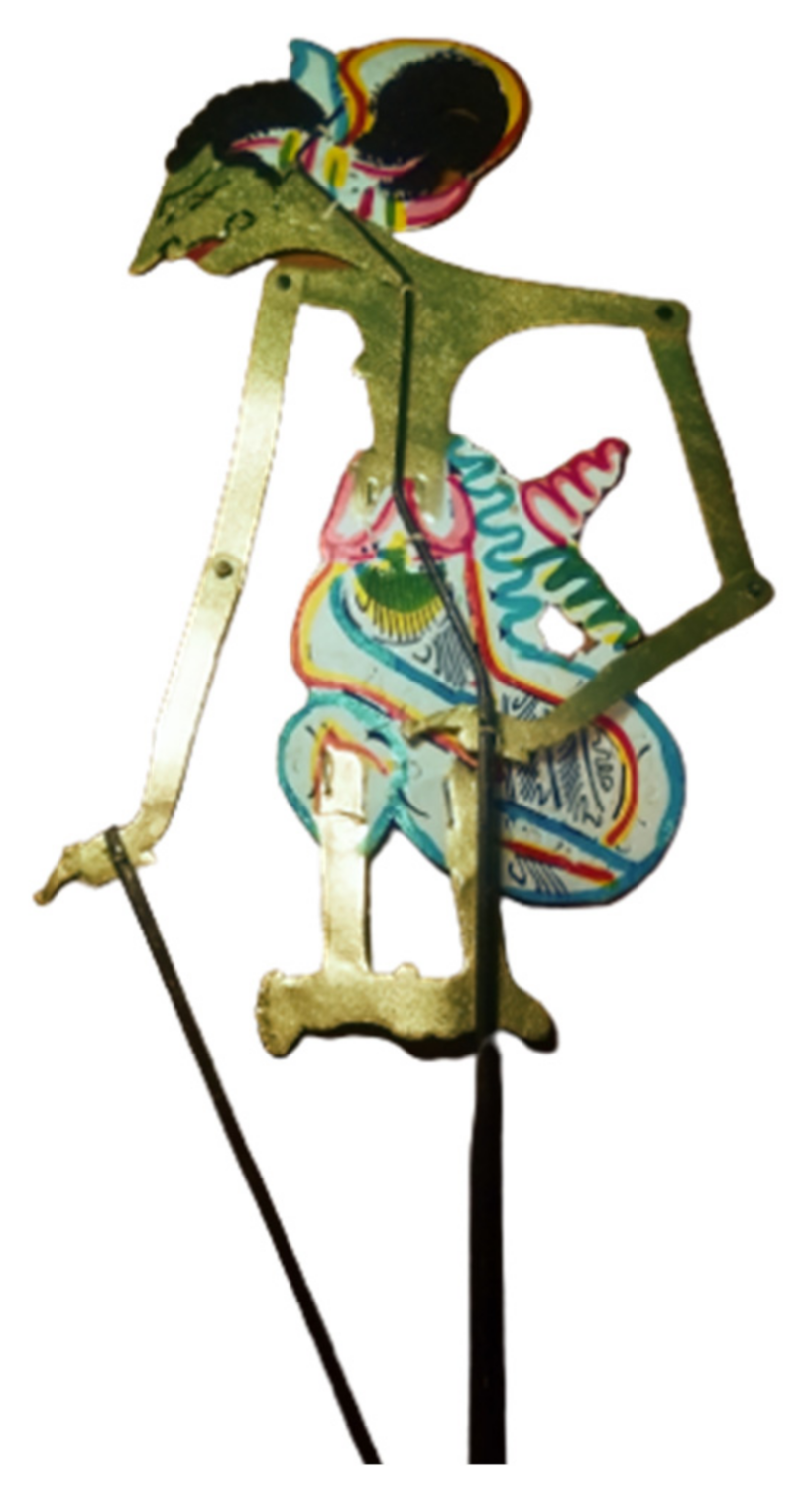
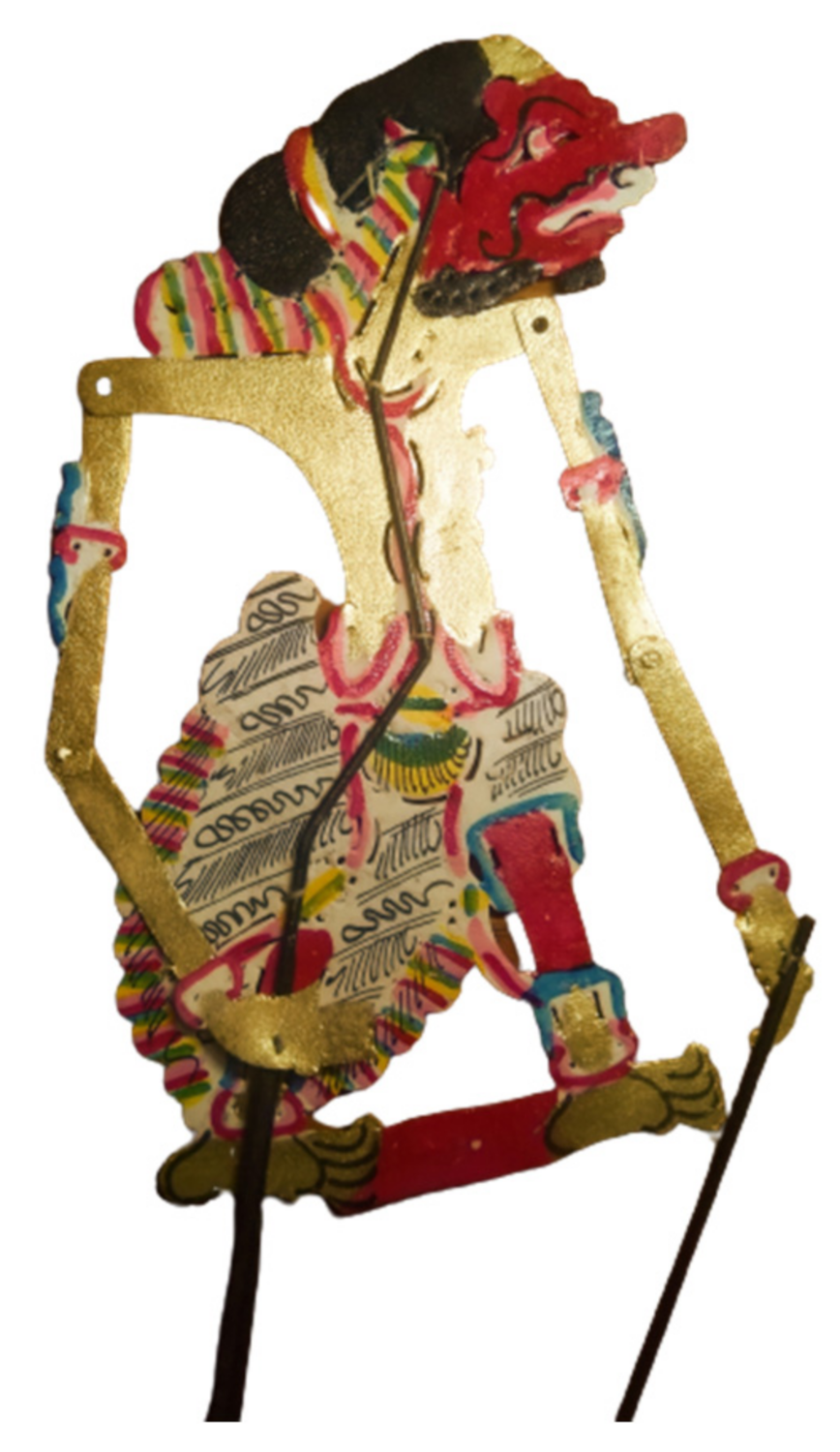
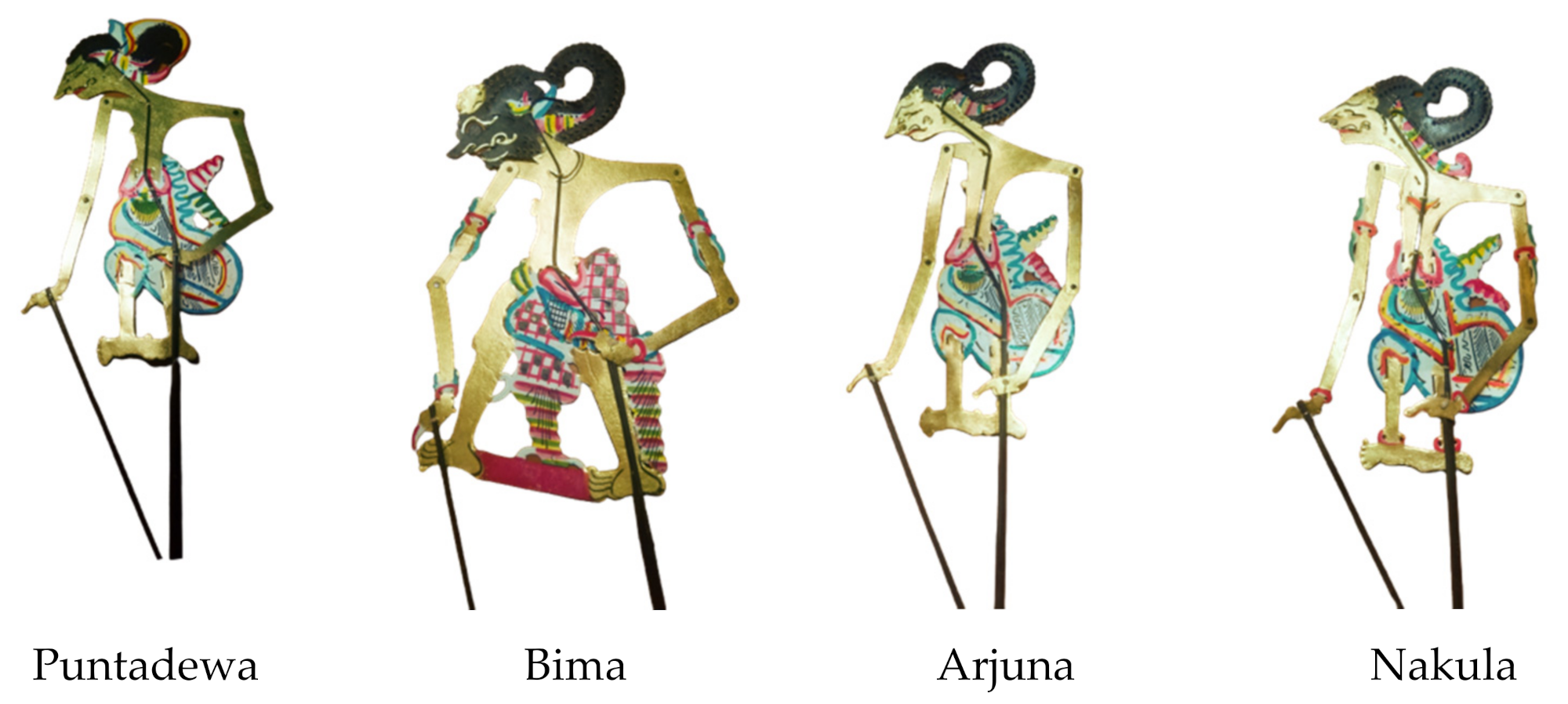
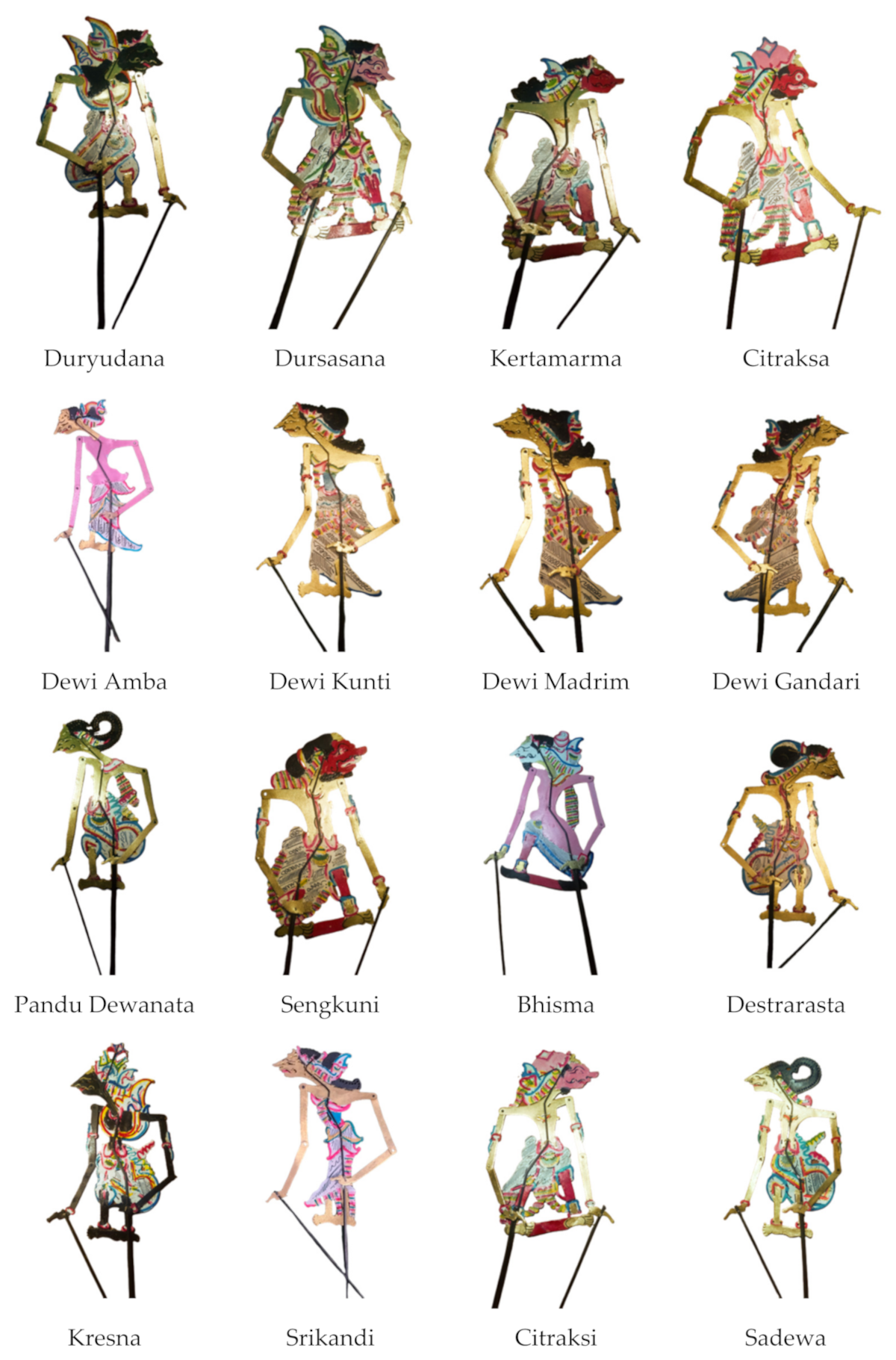
| RME Levels | Students Learning Paths | Learning Activities | Set Basic Concepts | Noble Values |
|---|---|---|---|---|
| Real Situation to Model of | Activity 1 Watching Mahabrata puppet stories | Watching and identify the character of the Mahabharata puppet | Universal set | The puppet stories could maintain the community identity |
| Model of to Model for | Activity 2 Composing the Mahabrata puppet in the kellir screen | Understanding the pattern, arrange the puppet in the kellir screen Classifying the puppet based on the evil or good characters Classifying the puppet of five groups of Pandhawa and Kurawa | Subsets | Understanding the good attitude performed by some puppet characters could be adopted, while the bad things should be avoided |
| Model for to Formal Knowledge | Activity 3 Write the set of Mahabrata Puppet | Define the sets, the member of sets, subsets and write all informal form | Definition and formal form of sets, members of sets and subsets | Enhance students’ understanding of the relation between the puppets’ characters and their position on the screen. Students will learn the philosophy of life that good people will be meet and become one as a group and vice versa. |
Publisher’s Note: MDPI stays neutral with regard to jurisdictional claims in published maps and institutional affiliations. |
© 2021 by the authors. Licensee MDPI, Basel, Switzerland. This article is an open access article distributed under the terms and conditions of the Creative Commons Attribution (CC BY) license (https://creativecommons.org/licenses/by/4.0/).
Share and Cite
Prahmana, R.C.I.; Istiandaru, A. Learning Sets Theory Using Shadow Puppet: A Study of Javanese Ethnomathematics. Mathematics 2021, 9, 2938. https://doi.org/10.3390/math9222938
Prahmana RCI, Istiandaru A. Learning Sets Theory Using Shadow Puppet: A Study of Javanese Ethnomathematics. Mathematics. 2021; 9(22):2938. https://doi.org/10.3390/math9222938
Chicago/Turabian StylePrahmana, Rully Charitas Indra, and Afit Istiandaru. 2021. "Learning Sets Theory Using Shadow Puppet: A Study of Javanese Ethnomathematics" Mathematics 9, no. 22: 2938. https://doi.org/10.3390/math9222938
APA StylePrahmana, R. C. I., & Istiandaru, A. (2021). Learning Sets Theory Using Shadow Puppet: A Study of Javanese Ethnomathematics. Mathematics, 9(22), 2938. https://doi.org/10.3390/math9222938







